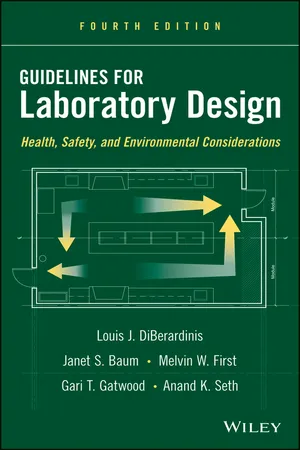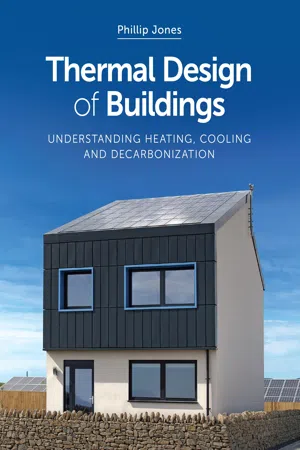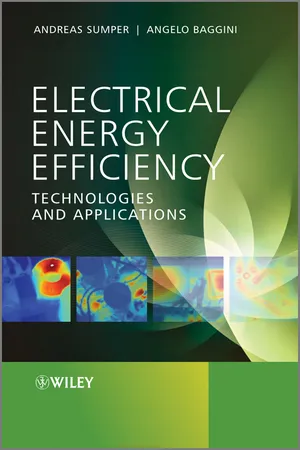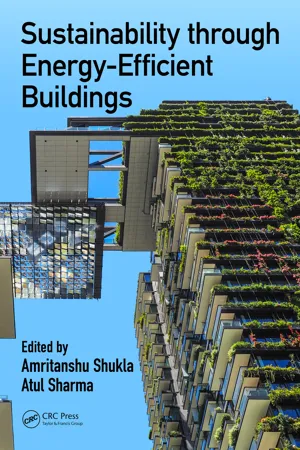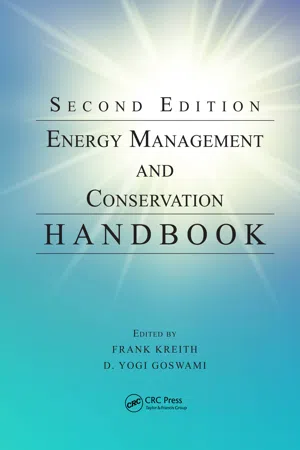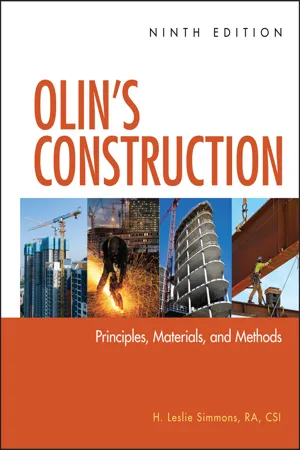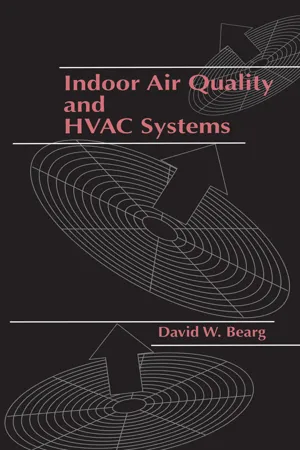Technology & Engineering
HVAC Systems
HVAC (Heating, Ventilation, and Air Conditioning) systems are designed to provide thermal comfort and acceptable indoor air quality. They regulate temperature, humidity, and air flow within buildings, ensuring a comfortable and healthy environment. HVAC systems are essential for maintaining optimal conditions in residential, commercial, and industrial spaces.
Written by Perlego with AI-assistance
Related key terms
Related key terms
1 of 4
Related key terms
1 of 3
10 Key excerpts on "HVAC Systems"
- B. Purushothama(Author)
- 2024(Publication Date)
- CRC Press(Publisher)
13 Designing HVAC13.1 What is HVAC?
The term HVAC refers to the three disciplines of Heating, Ventilating and Air Conditioning in air management and a fourth discipline, Controls which pervade the entire HVAC field. Controls determine how HVAC Systems operate to meet the design goals of comfort, safety and cost-effective operation.- Heating can be accomplished by heating the air within a space, or by heating the work area directly by radiation.
- Ventilating maintains an adequate mixture of gases in the air, controls odours and removes contaminants from occupied spaces. It can be accomplished passively through natural ventilation or actively through mechanical distribution systems.
- Air-conditioning refers to the sensible and latent cooling of air. Sensible cooling involves the control of air temperature while latent cooling involves the control of air humidity. Air is cooled by transferring heat between spaces, such as with a water loop heat pump system, or by rejecting it to the outside air via air-cooled or water-cooled equipment. Heat can also be rejected to the ground using geothermal exchange. Cool air is not comfortable if it is too humid. Air is dehumidified by condensing its moisture on a cold surface or by removing the moisture through absorption. In dry climates, humidification may be required for comfort instead of dehumidification. Evaporative humidification also cools the air. In such climates, it is possible to use radiant cooling systems, similar to the radiant heating systems.
- Controls ensure comfort, provide safe operation of the equipment and enable judicious use of energy resources. HVAC Systems are sized to meet heating and cooling loads that historically occur only 1% to 2.5% of the time. It is the function of the controls to ensure that the systems perform properly, reliably and efficiently during those conditions that occur 97.5% to 99% of the time.
Each HVAC discipline has specific design requirements and also opportunities for energy savings. However, energy savings in one area may augment or diminish savings in another. This applies to interactions between components of an HVAC system, as well as between the system and the lighting and envelope systems. Therefore, understanding how one system or subsystem affects another is essential to get the best of the opportunities for energy savings. This design approach is known as whole building design.- eBook - ePub
Guidelines for Laboratory Design
Health, Safety, and Environmental Considerations
- Louis J. DiBerardinis, Janet S. Baum, Melvin W. First, Gari T. Gatwood, Anand K. Seth(Authors)
- 2013(Publication Date)
- Wiley(Publisher)
PART IV HVAC SystemsWell-designed and well-operated heating, ventilating, and air-conditioning (HVAC) systems are essential for laboratory health and safety protection, as well as for an environment that promotes comfort, productivity, and good work practices. In some laboratories, such as cleanroom and microelectronics laboratories, the HVAC system contributes importantly to the functionality of the facility. This part of the book is concerned with the design of satisfactory HVAC Systems for laboratories in general and for a number of specific applications. It is also concerned with the selection and installation of HVAC equipment that is specifically designed for laboratory use, i.e., equipment that has been found to be reliable, long-lived, and efficient for the task. Energy conservation is addressed to aid building owners, operators, and design engineers to evaluate conservation strategies and systems that maintain health and safety of occupants. Energy conservation is a significant factor in achieving sustainable design (see Chapter 38).Some general information on the nature of HVAC Systems and equipment has been included to assist those not professionally involved with HVAC matters to understand the issues and to be prepared to assist in reaching critical decisions on cost and function.Passage contains an image 29 HVAC Systems
29.1 Description
This chapter is intended to provide a general background for those less familiar with the terminology used in describing heating, ventilating, and air-conditioning (HVAC) systems. It is by no means an exhaustive discussion of HVAC Systems. For more detailed information, see the current series of ASHRAE Handbooks on Fundamentals, HVAC Systems and Equipment, and HVAC Applications (ASHRAE, 2009–2012). Additional reference sources include classic works (Stoeker, 1958), as well as recent discussions by Kavannaugh (2006), Sauer and Code (2005), and Butterworth at al. (2007), and the ASHRAE Laboratory Design Guide - eBook - ePub
Thermal Design of Buildings
Understanding Heating, Cooling and Decarbonisation
- Phillip Jones(Author)
- 2021(Publication Date)
- The Crowood Press(Publisher)
Chapter Eight Active SystemsIntroduction
The active parts of thermal design are those that deliver heating, cooling and ventilation. The term HVAC is used to describe a heating (H), ventilation (V) and air conditioning (AC) system. At its simplest it will involve heating and natural ventilation, extending in complexity to include cooling, mechanical ventilation, moisture control and air filtration. Active HVAC Systems are based on engineering solutions, whereas passive design is more associated with architectural solutions. In general, we should maximize a building’s potential to provide thermal comfort and ventilation through passive design. However, for most locations, at some time, we will still need to provide heating, cooling and ventilation using some form of active mechanical system, which will consume energy that is traditionally sourced from fossil fuels, but is now increasingly from renewable energy sources.In our drive towards energy-efficient design, the main emphasis has been on passive design. Although heating, cooling and ventilation systems have become more energy efficient, their basic design has not changed significantly. We now need to be more innovative in how we achieve comfort in zero energy buildings, by providing appropriate and legible ways to generate, distribute and deliver thermal conditions, and, where possible, by reducing the size, complexity, space use and capital cost of HVAC equipment. HVAC Systems should be responsive to more efficient design, recognizing the greater significance of internal heat gains from people, lighting, appliances and processes, and the interaction with climate. As the demand on heating and cooling over time becomes more variable, the control of HVAC Systems becomes critical. Control can be automated to some extent, and can be smart, but not too smart that people do not understand it, and it must be able to be maintained and adjusted in response to changes in a building’s use over time.Fig. 8.1 Surface (left) and air (right) heat emitters and their delivery to the space. Surface systems will have a radiant and convective component of heat input, whereas air systems have just a convective heat input. - eBook - ePub
Electrical Energy Efficiency
Technologies and Applications
- Andreas Sumper, Angelo Baggini(Authors)
- 2012(Publication Date)
- Wiley(Publisher)
11 Heat, Ventilation and Air Conditioning (HVAC) Roberto Villafáfila-Robles and Jaume SalomHeating, ventilation and air conditioning (HVAC) systems are responsible for meeting the requirements of an indoor environment, with regard to air temperature, humidity and air quality by heating or cooling the spaces. HVAC Systems represent an important part of the energy needs in industry and building sectors as it has been shown that such systems consume most of the energy in buildings, requiring almost 50% of the total energy demand [1].HVAC Systems are part of an energy chain for conditioning a space using different energy sources and converting them into thermal energy to meet the required level of comfort (see Figure 11.1 ). HVAC Systems use fuels and electricity; fossil fuels are the most common source for heating whereas electricity is the almost the only source for cooling. Apart from cooling, electricity is also used to move fluids to enable thermal energy to reach the required spaces.Fans and pumps used in thermal generation and transportation processes are the main electric energy consumers in an HVAC system. These are driven by electric motors and their energy efficiency is related to the use of power electronics-based drives, a topic that is principally covered in Chapter 9. Apart from optimizing the consumption of these electrical devices, there is a great potential for energy savings in order to decrease the energy consumption of HVAC Systems as a whole, as well as in heat and cold generators. This can be achieved by reducing the thermal energy demand by passive methods and the use of renewable energy sources to support the production of both heat and cold. This chapter deals mainly with energy saving measures to reduce the thermal energy demand in HVAC Systems and, as a consequence, achieve higher energy efficiency ratios.Heat transfer is the basis of the performance of an HVAC system in order to heat or cool a space. This transference is performed in a set of heat exchangers (evaporators and condensers) that can be on their own or a part of a cool or heat generation device. Heat exchange processes are studied using thermodynamics. - Amritanshu Shukla, Atul Sharma, Amritanshu Shukla, Atul Sharma(Authors)
- 2018(Publication Date)
- CRC Press(Publisher)
Figure 9.2 . To accomplish this, the systems require transfer of the heat and moistness into and out of the air in addition to controlling the air pollutants level, by either directly removing them or by diluting them to tolerable levels. The heating systems increase the temperature in a space to compensate for heat losses concerning the interior space and outside. The ventilation systems supply air to space and extract contaminated air from it. The cooling of air available in the space is required to get the temperature down where heat gains have risen due to the presence of people, equipment, or the sun and are affecting human discomfort. HVAC Systems differ extensively in terms of size and the functions they perform. Some systems are large and central to the building services; these were probably designed when the building was initially commissioned and use ventilation to deliver heating and cooling. Other systems may provide heating through boilers and radiators, with some limited ventilation to provide fresh air or cooling to confident portions of the building such as conference rooms.In some cases, individual comfort cooling units have been added to a building to overcome a specific overheating problem that had not been thought of at the time of the original design. By considering HVAC Systems as a separate component rather than as an intermingling system, it would be informal to supervise the main area of energy wastage—that one element might influence one another, for example, it would be uneconomical to upsurge heating inside a building while the cooling system is combat to decrease temperatures. Consequently, it is worthwhile to look at how the components of an HVAC system interrelate with each other and fine tune every portion to save energy and money. Inappropriate design and indecorous installation of the HVAC system have an adverse effect on thermal comfort inside the buildings and on energy bills. Inappropriate design and installation of an HVAC system can intensely reduce the quality of air in a space. Poorly designed and poorly installed air circulation ducts can make unsafe conditions that may diminish the human comfort and degrade indoor air quality or even threaten the health of the homeowners.- eBook - ePub
Sustainable Architectural Design
An Overview
- Kuppaswamy Iyengar(Author)
- 2015(Publication Date)
- Routledge(Publisher)
Figure 5.2.2 ) address temperature and humidity control, ventilation, air motion and air filtration. In new construction, and in some retrofit situations, well-insulated and appropriately oriented buildings combined with passive design features using sun, night cooling, atriums, skylights, and daylighting to reduce heat from lighting can greatly reduce heating and cooling energy needs. Understanding interactions between all these systems offers a designer the opportunity to be creative in optimizing resource utilization and energy efficiency. In the US southwest, for example, evaporative cooling will use less energy than central HVAC Systems. This option should be weighed against the cost of water use needed for evaporative coolers.Except in certain commercial and institutional buildings, the purpose of an HVAC system is to heat or cool people, not buildings. This simple shift in viewpoint can offer changes in operational patterns, which make large energy savings possible. Instead of overheating rarely used hallways, designers can aim for optimum energy use based on the human needs for the space. Functions within a building, unrelated to HVAC, may restrict the extent to which energy can be successfully minimized, as in chemistry laboratories and clean-rooms, which might require 100 percent outside air. However, a focus on human requirements means that energy use is carefully directed, and may thus require smaller active systems.Figure 5.2.2 The functions of HVAC.(Source: image courtesy of Tim Padfield, conservationphysics.org.)Typical HVAC System Configuration
HVAC Systems are configured to provide heating, air-conditioning, and suitable ventilation (Figure 5.2.3 ). They can be separate or combined systems. The following system descriptions are organized into three main categories: heating, cooling, and ventilation/air distribution, although there is considerable overlap of these three parts.Heating Systems
Conceptually, heating is simple. A fuel is burned and the heat produced is distributed to different parts of a building. For heating a space, use of hot air, hot water, or steam can be employed. For both heating and cooling, an air distribution system requires a significant part of the building space for ducts. Water and electrical heating systems require less space than ducts to heat the same space. Also, sources of fuel for heating such as gas, oil, and solar require additional storage space in a building. These considerations will have great effect on the resulting building architecture. For larger commercial buildings, mostly hot water or steam is used. In these systems, hot water or steam is piped to a finned heat exchanger located in the ducts. The air that passes over this exchanger picks up the required heat energy which then will be forced into the occupied space. Broadly, heating systems classify into: - eBook - ePub
- Frank Kreith, D. Yogi Goswami, Frank Kreith, D. Yogi Goswami(Authors)
- 2016(Publication Date)
- CRC Press(Publisher)
6Heating, Ventilating, and Air-Conditioning Control Systems
Bryan P. Rasmussen, Jan F. Kreider, David E. Claridge, and Charles H. CulpCONTENTS
6.1 Introduction: The Need for Control 6.2 Modes of Feedback Control 6.3 Basic Control Hardware 6.3.1 Pneumatic Systems 6.3.2 Electronic Control Systems 6.4 Basic Control System Design Considerations 6.4.1 Steam and Liquid Flow Control 6.4.2 Airflow Control 6.5 Example HVAC System Control Systems 6.5.1 Outside Air Control 6.5.2 Heating Control 6.5.3 Cooling Control 6.5.4 Complete Systems 6.5.5 Other Systems 6.6 Commissioning and Operation of Control Systems 6.6.1 Control Commissioning Case Study 6.6.1.1 Design Conditions 6.6.1.2 Optimization of AHU Operation 6.6.1.3 Optimization at the Terminal Box Level 6.6.1.4 Water Loop Optimization 6.6.1.5 Central Plant Measures 6.6.1.6 Results 6.6.2 Commissioning Existing Buildings 6.7 Advanced Control System Design Topics 6.7.1 Nonlinear Compensation 6.7.1.1 Case Study: Nonlinear Compensation for Air Conditioning Expansion Valves 6.7.2 Model Predictive Control 6.7.2.1 Case Study: MPC for Air Conditioning Expansion Valves 6.8 Summary References6.1 Introduction: The Need for Control
This chapter describes the essentials of control systems for heating, ventilating, and air conditioning (HVAC) of buildings designed for energy conserving operation. Of course, there are other renewable and energy conserving systems that require control. The principles described herein for buildings also apply with appropriate and obvious modification to these other systems. For further reference, the reader is referred to several standard references in the list at the end of this chapter.HVAC system controls are the information link between varying energy demands on a building’s primary and secondary systems and the (usually) approximately uniform demands for indoor environmental conditions. Without a properly functioning control system, the most expensive, most thoroughly designed HVAC system will be a failure. It simply will not control indoor conditions to provide comfort. - eBook - ePub
Olin's Construction
Principles, Materials, and Methods
- H. Leslie Simmons(Author)
- 2011(Publication Date)
- Wiley(Publisher)
Chapter 16 Heating, Ventilating, and Air Conditioning (HVAC) Introduction Sustainability ConsiderationsApplicable MasterFormat TM SectionsHeat and Comfort Building Design Recommendations Heat Loss and Heat Gain Commissioning HVAC Controls HVAC Delivery Systems Central HVAC Equipment Decentralized HVAC Equipment Additional Reading Acknowledgments and References IntroductionEarly theories defined heat as a material substance called caloric , which was a weightless fluid that had the power to penetrate other materials, expand, and transform them into vapor. It was thought that a substance was hot or cold, depending on the proportion of caloric contained in its pores.The theory of heat was placed on a sound scientific basis in the early nineteenth century by James P. Joule, an English physicist. Joule's experiments led to the principle of conservation of energy , which stated that heat energy was not lost as it was used, but was transformed into an equivalent amount of another kind of energy. For instance, heat energy could be converted to kinetic (motion) energy by a steam engine and from kinetic energy to electric energy by a generator.Animals, including people, sustain life by converting organic food substances into heat energy. Normally, excess heat energy is produced and the body dissipates this excess to the surrounding atmosphere. Each organism has an optimum rate of body heat loss, depending on physical exertion. When the heat loss is at the ideal rate, a person feels comfortable. When heat is lost too rapidly, a person feels cold; when it is lost too slowly, a person feels hot. The objective of interior heat control is to create conditions in which the body loses heat at the optimum rate.Heat energy generally flows from a warmer region to one that is cooler. Therefore, the flow is to the outside of a building in winter and to the inside in summer. This heat flow affects interior surface and air temperatures.Cold is the absence of heat. A warm window radiates heat, but a cold window does not radiate cold. A person's sensation of coldness is caused by a rapid loss of body heat to the cold window surface. Likewise, the movement of air over the body produces the sensation of coldness because it carries off heat, not because it brings coldness. - eBook - ePub
- David W. Bearg(Author)
- 2019(Publication Date)
- CRC Press(Publisher)
CHAPTER 3 Individual Components of HVAC SystemsOVERVIEW
Before the performance of heating, ventilation, and air conditioning (HVAC) systems can be evaluated, it is necessary to first understand the specifics of the design of this system and the intended functioning of this equipment. This chapter presents a discussion of the individual component parts of HVAC Systems, including an explanation of the relationship between each of these components and the achievement of good indoor air quality (IAQ).Each component of the HVAC system has a specific importance to the resulting IAQ that the total system is capable of providing. This chapter discusses the role that the following components play in achieving good IAQ. As part of an inspection and testing effort, the condition of each of the components of the HVAC system needs to be considered. To facilitate this task, a checklist, such as the one presented in Figure 3.1 , can be used. One of the challenges of performing IAQ evaluations is that to be thorough, all aspects of the system need to be looked at. The performance of the overall system is dependent on the proper functioning of each of the individual components of the system.The following discussion of the relationship between each of these HVAC components and the achievement of good IAQ can be used in conjunction with an evaluation of the performance of a building and its systems. People already using another list of HVAC components, the “HVAC Checklist — Long Form” in the EPA/NIOSH document, Building Air Quality,1 - eBook - ePub
Energy Management Principles
Applications, Benefits, Savings
- Craig B. Smith, Kelly E. Parmenter(Authors)
- 2015(Publication Date)
- Elsevier(Publisher)
14 The standard covers different ways to comply with requirements, including the ventilation rate procedure, the indoor air quality procedure, and the natural ventilation procedure. The standard has evolved over time to reflect advances in building envelope designs. Today’s buildings are much tighter and energy efficient, but less air infiltration comes at the expense of needing greater mechanical ventilation to maintain air quality.• ISO 16814:2008 is an international standard that specifies methods for meeting target levels of acceptable indoor air quality.15• The World Health Organization (WHO) Regional Office for Europe also publishes standards for indoor air quality.Energy managers should be aware of all applicable codes and standards for HVAC Systems and take them into consideration in formulating the energy management program.16 ,17Description of Typical Air Distribution Systems
There are many types of HVAC Systems with different configurations for handling and distributing conditioned air to spaces (or zones) within the building. A few of the main categories of air distribution systems include terminal reheat, dual duct, multi-zone, and variable air volume. Some systems are also based on modifications to these main types, including hybrid configurations that combine features.Reheat Systems
Terminal or zone reheat systems provide chilled air to each zone. The air is then reheated depending on the temperature requirements of the zone using some type of heating system (e.g., electric resistance or hot water coils). (See Figure 8.11 ). Zones with large internal heat sources (lights, people, and equipment) will call for little or no additional heating. Other zones may require considerable additional heating. Since all air is first cooled, some duplicate energy use is bound to occur. Therefore, these systems are very inefficient and building codes often restrict their use, unless they are accompanied with features to improve efficiency. One modification is to use controls that increase the supply air temperature when the cooling load in the warmest area of the building decreases. Known as temperature reset or variable temperature
Index pages curate the most relevant extracts from our library of academic textbooks. They’ve been created using an in-house natural language model (NLM), each adding context and meaning to key research topics.
Explore more topic indexes
Explore more topic indexes
1 of 6
Explore more topic indexes
1 of 4

